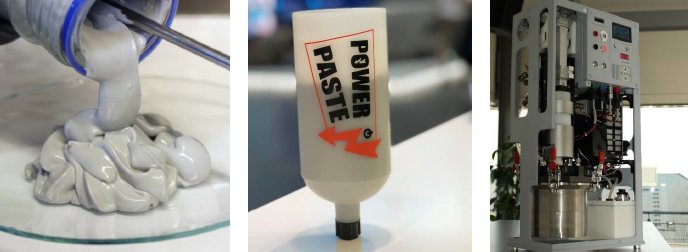POWERPASTE is an ultra high capacity hydrogen storage medium for PEM fuel cells invented and developed by Fraunhofer IFAM . POWERPASTE generates hydrogen on contact with water. The hydrogen capacity is about 10 wt% (i.e. 10 kg POWERPASTE → 1 kg hydrogen). This is a specific energy of 1.6 kWh / kg and an energy density of 1.9 kWh / liter, which is about 10 times the capacity of lithium-ion batteries. The award-winning POWERPASTE technology is patented (EU, US) and has many advantages over other energy storage technologies, in particular in the power range from 100 W to 10 kW.

A schematic representation of the operating principle of a power supply based on POWERPASTE is shown in the following diagram:

Unlike batteries, POWERPASTE power systems are independent of mains power and can be recharged in seconds by replacing the cartridge. In addition, POWERPASTE is highly stable and does not self-discharge. Capital costs per unit power and total cost of ownership for power systems based on POWERPASTE are comparable, in particular in the power range from 100 W to 10 kW, for example, for UAVs with long flight times or vehicles with extended range, as well as for various stationary applications such as standby power generators.
POWERPASTE , MgH2, . POWERPASTE :

POWERPASTE
, . . , ( ) . :

:
. ( , ) . - . , .
. (, , ) (CO2).
. (DMFC), CO2. - .
, , - , , CO2. . POWERPASTE .
100 10 :

- . , , ( , ):

POWERPASTE
, ( ). ( ) . (NaBH4) ( ). , 15 / .
, . , :
MgH2 + 2 H2O → 2 H2 + Mg(OH)2
, c , / , . - . , Fraunhofer IFAM, .
, , NaBH4, , . POWERPASTE, , , Fraunhofer IFAM :
1,9 /
/
( +/- 90 ° )
( 5 )
( 2 / POWERPASTE)

POWERPASTE . ( , ) .
POWERPASTE
POWERPASTE : POWERPASTE, , , PEM, , / . :

By metering precise amounts of POWERPASTE and water, the reaction in the hydrogen generator is controlled so that the amount of hydrogen produced exactly matches the hydrogen consumption of the fuel cell, ensuring a low pressure in the system and therefore reducing its weight. Refueling simply means replacing cartridges, making it extremely fast.